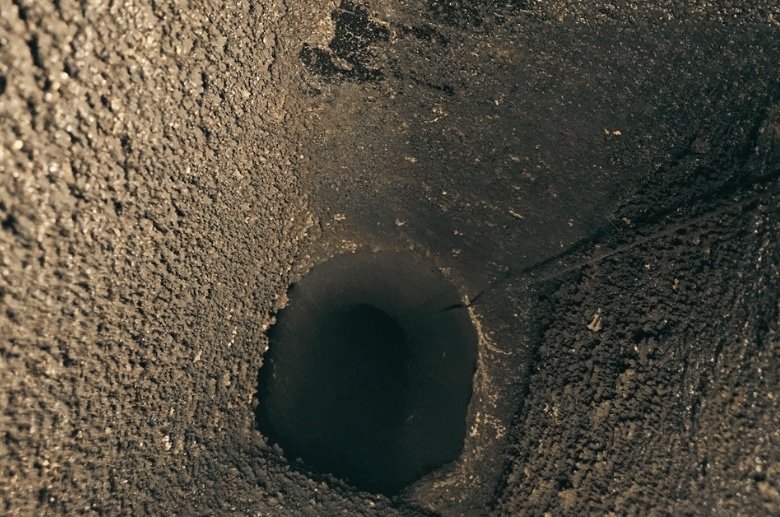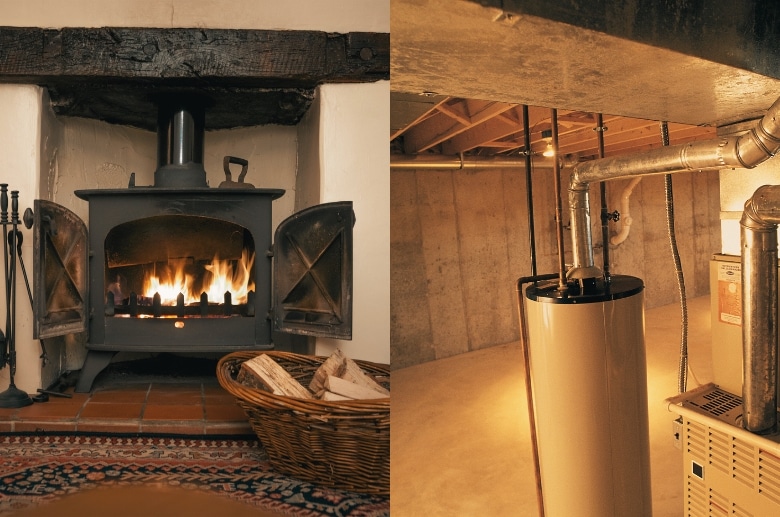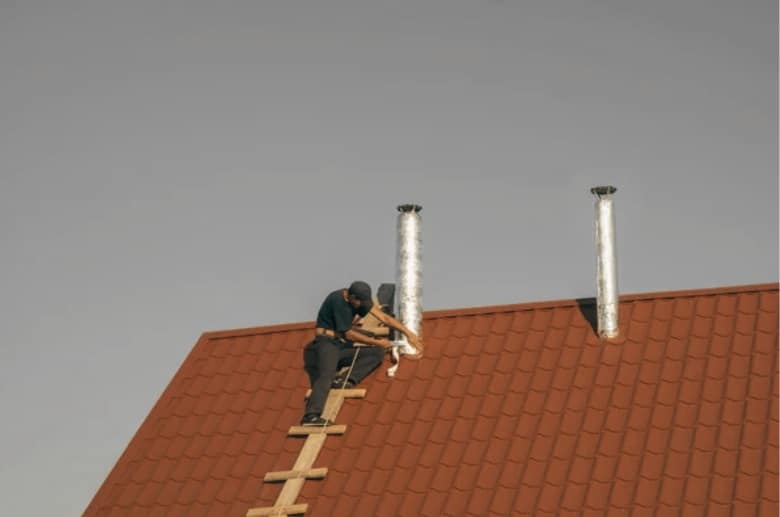Two flues in your chimney sound impressive, but when smoke fills your home instead, it’s frustrating.

Before we dive in, let’s acknowledge the importance of proper maintenance. Just like a healthy heart, a well-maintained double flue ensures smooth airflow and keeps smoke where it belongs – outside!
Read on to ensure you get clean indoor air in your home.
Causes of Double Flue Chimney Smoke Problems
As highlighted, double flue chimney smoke problems can arise from various causes, impacting both functionality and safety. Now, let’s investigate the root causes of this smoky situation.
——
Do You Need to Hire Chimney & Fireplace Expert?
Get free quotes from qualified experts near you. No commitment required!
——
1. Chimney Too Short or Improperly Sized
An undersized or improperly sized chimney can’t create enough draft to pull smoke efficiently. Instead, it can cause the smoke from your fireplace to recede into your home.
According to the United States Environmental Protection Agency (EPA), poorly designed chimneys contribute to increased indoor air pollution, resulting in respiratory issues and carbon monoxide poisoning.
To avoid this and ensure your chimney’s size is up to code, you need to incorporate the 3-2-10 chimney rule. This rule states that the chimney’s shortest side must be at least 3 feet above the roof’s penetration, and its top must be 2 feet higher than any part of the building within 10 feet.
This ensures proper draft and prevents downdrafts that push smoke back into your home.
2. Blockages and Buildup Inside the Chimney

Over time, your chimney accumulates creosote (a tar-like residue from burning), leaves, debris, and even animal nests. These blockages restrict airflow, forcing smoke back into your home.
A study published by the Centers for Disease Control (CDC) warns that creosote buildup is not only a fire hazard but also releases pollutants such as benzene and formaldehyde, which can contribute to respiratory problems.
Fortunately, you can prevent this problem by prioritizing regular chimney cleanings (at least once per year).
3. Damaged Flue Liner
The flue liner protects the chimney structure and efficiently channels smoke. Cracks, holes, or missing sections allow smoke to leak and potentially enter your living space. Damage can occur due to age, improper installation, or harsh weather.
The infiltration of smoke can lead to respiratory problems, irritation of the eyes, and potential exposure to harmful substances present in the smoke, such as creosote.
Regular inspection and maintenance of the flue liner are crucial to prevent these issues and ensure the efficient operation of the chimney and the safety of the homeowners.
4. Short Chimney Cap
A short or improperly fitted chimney cap can contribute to smoke problems by allowing downdrafts or wind-driven rain to enter the chimney. This disrupts the proper draft and ventilation, causing smoke to linger and escape into the living space.
Installing a correctly sized and well-fitted chimney cap is essential to prevent these issues and safeguard the indoor air quality. Most building codes require a cap that extends at least 2 inches beyond the flue and is vented to prevent downdrafts.
5. Operating Multiple Appliances Through a Single Chimney

When multiple appliances (fireplace, furnace, water heater) share a single flue, competition for the draft space arises. This can cause back-drafting, especially if one appliance isn’t properly vented or operates simultaneously with another. For optimal safety and efficiency, each appliance requires a dedicated flue.
This not only diminishes the performance of the appliances but also poses significant health risks, including headaches, dizziness, and, in extreme cases, carbon monoxide poisoning.
Resolving Double Flue Chimney Smoke Issues
Experiencing smoke issues with your double flue chimney can be stressful! But for every double flue chimney smoke problem, we have a solution.
1. Improving Airflow and Draft
If your double flue chimney isn’t drawing up smoke properly, here are some effective ways to address the issue.
Diagnosing Draft Issues
To identify airflow problems causing smoke backdraft, employ effective methods such as smoke tests or draft gauges.
First, light a smoke tube (available at fireplace stores) near the fireplace opening. Observe the smoke’s movement: If it travels erratically or down the flue, your draft is weak.
Next, measure the pressure difference between your room and the chimney. Positive pressure indicates back-drafting, while negative pressure shows proper draft.
Balancing Air Pressure
Balancing air pressure involves opening windows/doors on opposite sides of the house from the fireplace to create a cross-flow path. Closing unused flues can also help focus the draft.
Moreover, you need to ensure balanced ventilation systems (e.g., exhaust fans) don’t compete with the chimney draft.
Boosting Draft Efficiency
Lastly, enhance draft efficiency by exploring options like draft inducers or extending the chimney.
Incorporating these solutions into the system can effectively amplify airflow, reducing the likelihood of smoke-related problems and ensuring a consistently strong draft in your double flue chimney.
2. Regular Inspection and Routine Maintenance
This is straightforward. Here’s what you need to do.
The Necessity of Chimney Care
Regular inspections (yearly) and cleanings (at least once a year) by certified professionals are crucial. A chimney sweep can identify and address issues early on, preventing major problems and ensuring safe and efficient operation.
Additionally, regular cleanings (especially before and after peak fireplace season) remove creosote buildup, reducing fire risk and ensuring efficient airflow.
Conducting Chimney Inspections
Here’s how to do this effectively:
- Visual Check: Inspect the chimney exterior for cracks, loose bricks, or damaged flashing.
- Flashlight Exploration: Shine a flashlight into the flue opening to check for blockages, creosote buildup, or animal nests.
- Damper Function: Ensure the damper opens and closes smoothly, creating a tight seal when closed.
Combating Creosote Accumulation
As explained earlier, creosote buildup poses a significant threat to your home and family. To mitigate this risk, here’s what you need to do:
- Burn Dry, Seasoned Wood: Burning wood with less than 20% moisture content minimizes creosote formation.
- Creosote Logs: Use these occasionally in fireplaces to help burn off existing creosote buildup within the flue.
Addressing creosote accumulation effectively ensures a clean and efficient chimney, reduces the risk of chimney fires, and ensures the system’s longevity.
——
Do You Need to Hire Chimney & Fireplace Expert?
Get free quotes from qualified experts near you. No commitment required!
——
3. Repair and Upgrades
The following is how you can repair and upgrade your chimney:
Addressing Structural Issues
Resolving any structural concerns is important to address double flue chimney smoke issues. Here’s how to do it.
- Crack & Leak Repair: Seek professional assistance to repair cracks in the chimney structure or damaged mortar joints to prevent leaks and smoke infiltration.
- Flue Liner Replacement: Cracked or missing flue liners pose a serious safety hazard and require immediate professional replacement.
Chimney System Upgrades
Consider upgrading your chimney system to enhance functionality. Upgrade to a taller cap that meets local regulations and wind patterns to prevent downdrafts.
Additionally, consider replacing faulty dampers with top-sealing dampers that create a tighter seal and prevent smoke leaks. If your existing liner is outdated or damaged, consider upgrading to a more durable material like stainless steel for improved longevity and performance.
Should You Hire a Pro for Double Flue Chimney Smoke Issues?

While the previous sections equipped you with knowledge and DIY solutions for tackling common double flue smoke problems, there are situations where professional intervention becomes crucial. Here’s when seeking expert help is the wisest course of action:
- Unexplained Smoke Backdraft: If you’ve tried DIY solutions like airflow balancing and draft improvement measures without success, a professional can use specialized tools and expertise to pinpoint the root cause and recommend tailored solutions.
- Structural Concerns: Addressing cracks, leaks, or major damage to the chimney structure or flue liner requires professional assessment and repair techniques beyond DIY capabilities for safety reasons.
- Multiple Appliance Sharing a Flue: Modifying venting systems or installing separate flues for multiple appliances necessitates professional expertise to ensure code compliance and optimal functionality.
- Chimney Cleaning: Removing heavy creosote buildup or dealing with a blockage, such as an animal nest, often requires specialized tools and techniques for safe and effective cleaning. Professionals are trained and equipped to handle these tasks efficiently and minimize potential hazards.
- Warranty and Insurance Coverage: Many repairs and maintenance tasks performed by certified professionals come with warranties, offering additional peace of mind and potential insurance coverage in case of issues.
——
Do You Need to Hire Chimney & Fireplace Expert?
Get free quotes from qualified experts near you. No commitment required!
——
How to Prevent Smoke Problems in Double Flue Chimneys
Now that you’re armed with the knowledge to diagnose and resolve smoke issues, let’s shift gears to prevention – the key to enjoying a smoke-free haven year-round.
Prime the Flue
Priming involves warming the chimney to create a draft. This can be achieved by lighting a small, easily controllable fire using newspaper or kindling. By doing so, you initiate an upward flow of air that helps establish a proper draft before adding larger fuel.
This process ensures that the flue is adequately heated and ready to channel smoke upwards efficiently, reducing the likelihood of smoke escaping into your living space.
Burn Dry Seasoned Wood
Wet or green wood produces excess smoke, leading to creosote buildup and decreased chimney efficiency. Dry seasoned wood, with moisture content below 20%, ensures a cleaner and more efficient burn. This type of wood ignites faster, produces less smoke, and minimizes the risk of chimney fires.
Additionally, regularly inspect and clean your chimney, as even with seasoned wood, some creosote accumulation is inevitable. Choosing the right fuel significantly contributes to maintaining a well-functioning double flue chimney and ensuring a safe and enjoyable fireplace experience.
Consider Using Smoke Guard
A smoke guard, also known as a chimney cap, is a metal shield installed on top of your chimney. It helps prevent downdrafts caused by wind, ensuring smoke exits smoothly and doesn’t get blown back down the flue.
That’s not all. This simple yet effective device enhances the chimney’s performance, ensuring that smoke is efficiently directed up and out of the flue.
For the best results, consult with chimney professionals to assess your specific needs and determine the most suitable smoke guard products for your double flue chimney.
Conclusion
Navigating the complexities of double flue chimneys can be daunting, but remember that understanding the causes, solutions, and preventive measures empowers you to create a smoke-free haven.
Here’s a summary of what you need to do:
- Recognize common causes like improper drafts, blockages, damaged flues, and multiple appliances sharing a flue.
- Utilize DIY solutions like airflow balancing, draft improvement measures, and routine cleaning.
- When faced with complex diagnoses, structural concerns, or safety-critical tasks, prioritize expert intervention from certified chimney sweeps.
- Implement practices like burning dry wood, priming the flue, using a smoke guard, and scheduling regular inspections and cleanings.
By prioritizing chimney maintenance and acting proactively, you can transform your double flue chimney smoke problems into a delightful source of warmth and comfort.
Schedule your annual chimney inspection today to ensure a safe and smoke-free winter season






